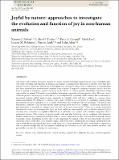Joyful by nature : approaches to investigate the evolution and function of joy in non-human animals
Abstract
The nature and evolution of positive emotion is a major question remaining unanswered in science and philosophy. The study of feelings and emotions in humans and animals is dominated by discussion of affective states that have negative valence. Given the clinical and social significance of negative affect, such as depression, it is unsurprising that these emotions have received more attention from scientists. Compared to negative emotions, such as fear that leads to fleeing or avoidance, positive emotions are less likely to result in specific, identifiable, behaviours being expressed by an animal. This makes it particularly challenging to quantify and study positive affect. However, bursts of intense positive emotion (joy) are more likely to be accompanied by externally visible markers, like vocalisations or movement patterns, which make it more amenable to scientific study and more resilient to concerns about anthropomorphism. We define joy as intense, brief, and event-driven (i.e. a response to something), which permits investigation into how animals react to a variety of situations that would provoke joy in humans. This means that behavioural correlates of joy are measurable, either through newly discovered 'laughter' vocalisations, increases in play behaviour, or reactions to cognitive bias tests that can be used across species. There are a range of potential situations that cause joy in humans that have not been studied in other animals, such as whether animals feel joy on sunny days, when they accomplish a difficult feat, or when they are reunited with a familiar companion after a prolonged absence. Observations of species-specific calls and play behaviour can be combined with biometric markers and reactions to ambiguous stimuli in order to enable comparisons of affect between phylogenetically distant taxonomic groups. Identifying positive affect is also important for animal welfare because knowledge of positive emotional states would allow us to monitor animal well-being better. Additionally, measuring if phylogenetically and ecologically distant animals play more, laugh more, or act more optimistically after certain kinds of experiences will also provide insight into the mechanisms underlying the evolution of joy and other positive emotions, and potentially even into the evolution of consciousness.
Citation
Nelson , X , Taylor , A , Cartmill , E , Lyn , H , Robinson , L , Janik , V M & Allen , C 2023 , ' Joyful by nature : approaches to investigate the evolution and function of joy in non-human animals ' , Biological Reviews , vol. 98 , no. 5 , pp. 1548-1563 . https://doi.org/10.1111/brv.12965
Publication
Biological Reviews
Status
Peer reviewed
ISSN
1464-7931Type
Journal article
Description
Funding: This work was supported by Grant #0333 from the Templeton World Charity Foundation (TWCF) and a Brian Mason Technical Trust Fund grant to X. J. N. and A. H. T.Collections
Items in the St Andrews Research Repository are protected by copyright, with all rights reserved, unless otherwise indicated.

